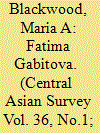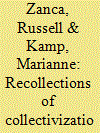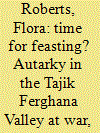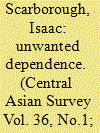|
|
|
Sort Order |
|
|
|
Items / Page
|
|
|
|
|
|
|
| Srl | Item |
| 1 |
ID:
152011


|
|
|
|
|
| Summary/Abstract |
This article examines the personal papers of Fatima Gabitova, a writer and pedagogue who fell victim to Stalinist repression as a ‘wife of an enemy of the people’ in the Kazakh SSR. Gabitova’s life was in many ways extraordinary, and many of her experiences were hardly typical. Nevertheless, her exposure to Kazakhstan’s cultural and political elites and the rich textual archive she left behind provide a highly nuanced window into the lived experience of Stalinism in Kazakhstan. Her writings, which include journals, poetry, letters and memoiristic essays, reveal a highly articulated sense of self that was informed and influenced by the realities of life under Stalinism, but was not ultimately determined by the parameters of the Soviet system. Throughout her personal writings, Gabitova exhibits a complicated ambivalence towards the reality of Soviet rule that demonstrates the broader contradictions of Stalinism as a system that was at once repressive and participatory.
|
|
|
|
|
|
|
|
|
|
|
|
|
|
|
|
| 2 |
ID:
152013


|
|
|
|
|
| Summary/Abstract |
This article analyses the late-Stalinist waves of repression in the Uzbek SSR against the background of the legacy of World War II. Drawing on new archival evidence, the article shows how postwar conditions influenced the Stalin leadership’s decision to unleash repressive campaigns and how the specific circumstances in the Uzbek SSR influenced the course of the campaigns. The article argues, first, that the late-Stalinist purges in the Uzbek SSR were primarily directed by the regime’s desire to regain control over the production base but that the desire to overcome ‘backwardness’ remained a prominent goal. Second, the article argues that repression in the Uzbek SSR can be divided into two phases, underlying an intensifying dynamic due to central leadership intervention in Uzbek affairs. The first phase (1946–1949) focused primarily on the Uzbek intelligentsia; the second phase (1949–1953) intensified repression through party purges so as to ensure institutional functioning in party and state, which included measures to uproot patronage networks, overcome backward behaviour and establish party discipline.
|
|
|
|
|
|
|
|
|
|
|
|
|
|
|
|
| 3 |
ID:
152008


|
|
|
|
|
| Summary/Abstract |
Collectivization of agriculture in Uzbekistan demanded the efforts of many local agitators who called on Uzbek dehqons to join kolkhozes, and who stimulated a local version of class warfare. In oral history interviews with those who experienced mass collectivization’s first moments, we find both the brutality of change imposed from above and a social transformation led by local Uzbek activists. We argue that Uzbek agitators allowed many dehqons to identify with this project to change rural land ownership, and that their offers of tangible benefits, such as advance payments for cotton crops and distribution of food, provided strong incentives for joining. Class rhetoric was important as activists divided the poor from the kulak and used threats of dekulakization, as well as incentives, to promote rapid collectivization.
|
|
|
|
|
|
|
|
|
|
|
|
|
|
|
|
| 4 |
ID:
152012


|
|
|
|
|
| Summary/Abstract |
The article analyses governance practices in a Central Asian kolkhoz between the 1930s and early 1950s. It investigates the process of the kolkhoz’s construction, economic activities and structures of authority. Focusing on the figure of the kolkhoz chair (rais), the article scrutinizes the range of the rais’s duties and powers. By examining his relations with kolkhoz peasants, their strategies for instigating and resolving local conflicts, and their mechanisms for and the limitations on integrating his personal networks to gain authority, the article highlights the evolution of the political and social roles of the kolkhoz chair over the two decades between 1930s and 1950s. It argues that the transition of the rais from an insignificant to a powerful figure in the Soviet state was directly connected to the rise of the cotton industry in Tajikistan. The author proposes rethinking the period of Stalinism as dynamically evolving in diverse contexts, producing a variety of ‘Stalinisms’ which contradicted and amended each other.
|
|
|
|
|
|
|
|
|
|
|
|
|
|
|
|
| 5 |
ID:
152009


|
|
|
|
|
| Summary/Abstract |
Based on research in Russian and Kazakhstani archives, this article investigates connections between policies of peasant colonization, the sedentarization of pastoral nomadic peoples, and the economic regionalization of the USSR. After analysing debates from the 1920s, and limited sedentarization among Kazakhs and Kyrgyz during collectivization, the article argues that only by focusing on the economic regionalization of Central Asia, which placed the Kazakhs and the Kyrgyz in two different economic regions with dissimilar priorities, is it possible to explain the radically different outcomes of early Stalinist policies for similar pastoral peoples. The increased central control brought by the Stalinist Great Turn created a new spatial hierarchy directly connecting the bottom of the Soviet social and spatial pyramid, the livestock-breeding regions, to its top, the elite regime cities. The exclusion of the Kyrgyz ASSR from the massive livestock procurements that fed the Soviet political and industrial centres, and which led to the great famine in Kazakhstan (1931–33), can be explained by early Stalinist economic regionalization.
|
|
|
|
|
|
|
|
|
|
|
|
|
|
|
|
| 6 |
ID:
152006


|
|
|
|
|
| Summary/Abstract |
This article analyses the paradoxically central role of a railroad in Soviet economic growth in southern Tajikistan’s Vakhsh River valley during the 1930s. Constructed as a secondary service road of the Vakhshstroi agro-industrial complex, it was not meant to support enterprises throughout the region. Because of the republic’s lack of roads, however, unrelated freightage operations gravitated to the Vakhsh Railroad and made it the unintended mediator of the developing geography of Soviet movement. By examining how the narrow gauge line was used in unplanned ways, I find that state building under Stalin was characterized by improvisation in labour and mobility. Furthermore, the material conditions of transportation limited the locations of economic possibility in unanticipated ways. This case demonstrates that studying the use of infrastructure can further historical understanding of causes, effects and chronologies of economic life in the Stalin era.
|
|
|
|
|
|
|
|
|
|
|
|
|
|
|
|
| 7 |
ID:
152007


|
|
|
|
|
| Summary/Abstract |
The well-established narrative of the Soviet Union’s victory in the Great Patriotic War emphasizes the enormous sacrifices that it entailed, and the extraordinary sufferings of both the Red Army and the entire civilian population. Throughout the war years, however, reports of lavish feasting and conspicuous consumption taking place on collective farms in northern Tajikistan continued to be submitted to Moscow. The ‘culprits’ were usually local Soviet officials, who appear to have reverted to traditional redistributive practices and modes of patronage. I argue that such acts of ‘anti-Soviet sabotage’ do not necessarily prove that Central Asians understood themselves as colonized subjects making the most of a temporary reprieve from state intrusion. The war in fact casts into sharp relief the extent to which many local officials of the Tajik SSR perceived themselves as loyal Soviet citizens – and as good Muslims, too.
|
|
|
|
|
|
|
|
|
|
|
|
|
|
|
|
| 8 |
ID:
152005


|
|
|
|
|
| Summary/Abstract |
Stalin never personally visited Central Asia, yet the region underwent major transformations during the period of his rule. This special issue is not devoted to Stalin’s personal ideas about the development of Soviet Central Asia. Rather, it is an attempt to understand those who experienced and co-shaped that period in various Central Asian contexts and how those experiences figured in the Stalinist regime overall. Shifting the focus away from the study of Moscow’s ideological ambitions and top-down national construction, the authors explore the everyday experiences ‘on the ground’ in order to (re)discover the place of Central Asia in the larger map of Stalinist governance.
|
|
|
|
|
|
|
|
|
|
|
|
|
|
|
|
| 9 |
ID:
152010


|
|
|
|
|
| Summary/Abstract |
Based on an analysis of the bureaucratic interactions between deported Chechen and Ingush ‘special settlers’ (spetspereselentsy) and local state institutions in late-Stalinist Kazakhstan (1944–1953), this article argues that the deportees’ acts of assimilation can be seen as representative of the contradictory dual relationship of victimization and dependence faced by the majority of Soviet citizens in one form or another during late Stalinism. Rather than an entirely peripheral and unusual case, moreover, this narrative of Chechen and Ingush assimilation in Kazakhstan may have important implications for the study of state–citizen relations throughout Central Asia and the whole of the USSR.
|
|
|
|
|
|
|
|
|
|
|
|
|
|
|
|
|
|
|
|
|